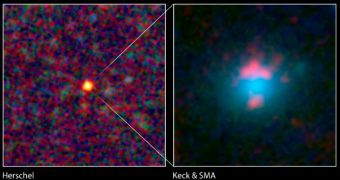The European Space Agency's Herschel Space Observatory is the most advanced piece of astronomical hardware in orbit today, and this shows through its skills. The telescope is capable of seeing magnified galaxies enshrouded in dust from distances that can put all other telescopes to shame.
The European observatory has a wide array of skills, and an important suite of scientific instruments, but astronomers did not know it was this good at finding the elusive galaxies.
Scientists say that this is possible because Herschel can use cosmic magnifying lenses, in a process called gravitational lensing. This ability relies heavily on dark matter.
Cosmic lensing is a relatively simple-to -understand concept. Light from a distant galaxy that travels to Earth at some point is impeded by another galaxy that is in its way, and the latter bends the light from the former.
This happens due to the fact that it has a strong gravitational pull, and also because halos of dark matter generally surround galaxies, keeping them together.
When viewed from Earth, light emitted from the galaxy in the background is seen as distorted by the actions of the galaxy in the foreground. The image appears magnified on scientists' computers.
“I was surprised to learn that Herschel is so good at finding these cosmic lenses. Locating new lenses is an arduous task that involves slogging through tons of data,” says expert Asantha Cooray.
“With Herschel, we can find a lot of them much more efficiently,” adds the astronomer, who is based at the University of California in Irvine (UCI).
She is also one of the coauthors of a new paper detailing the findings, which is published in the November 5 issue of the top journal Science. Open University expert Mattia Negrello was the lead author of the research.
“With these [galactic] lenses, we can do cosmology and study galaxies that are too distant and faint to be seen otherwise,” Cooray reveals. Herschel is capable of using them with great proficiency, thus obtaining readings that are unaccessible to other telescopes.
In a recent survey of the sky it conducted, the ESA telescope discovered 5 galaxies that had never been observed before. The objects lie between 9 and 11 billion years ago from Earth, and date back to a time when the Universe was very young.
“The fact that this Herschel team saw five lensed galaxies is very exciting. This means that we can probably pick out hundreds of new lensed galaxies in the Herschel data,” says Paul Goldsmith.
The expert is the US project scientist for Herschel, and he is based at the NASA Jet Propulsion Laboratory (JPL), in Pasadena, California.

 14 DAY TRIAL //
14 DAY TRIAL //